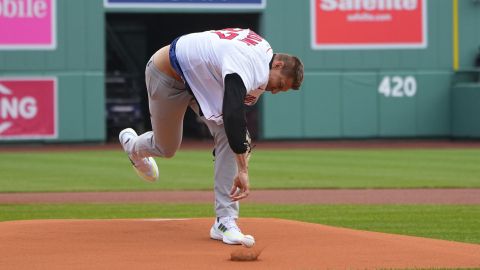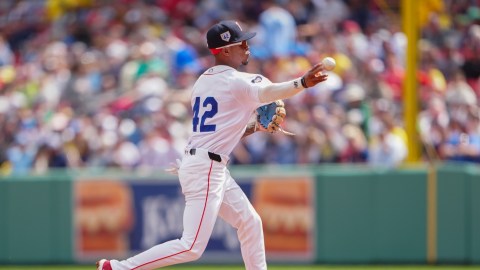It was an embarrassing stain on an otherwise successful 2009 campaign for the Boston Red Sox. It was the source of frustration for countless fans, and it was a problem that wouldn't go away.
It was the Red Sox' inability to prevent baserunners from stealing bags at will, and it simply cannot happen again in 2010.
By now, you know the stats. The 2009 Red Sox ranked dead last at throwing out base stealers at a 13 percent rate. The closest team was Colorado, which was still six percentage points better than the Sox.
To put that in perspective, look at every season since 1998, the year Jason Varitek became a regular contributor behind the plate when he served as Scott Hatteberg's backup. Since '98, the best the Red Sox have finished in caught stealing percentage was 18th in 1998, with the second-best finish coming in 2007, when the club was 19th-best in the majors. The worst finish — aside from that of 2009 — was, somewhat surprisingly, the 2004 season, when the Red Sox were hundredths of percentage points worse than the Phillies and finished dead last in the majors.
Obviously, that '04 team went on to shock the world, break all sorts of curses and ride Duck Boats around Boston in October, but that team, while defensively sound and stacked with pitching, was known just as much for its big boppers. Plus, even that '04 number was a somewhat respectable 20 percent, only 10 points off the league average (the '09 Red Sox were 15 percentage points off the league average).
This year, Theo Epstein's focus is clearly on pitching and defense, and finishing 30th out of 30 simply won't cut it.
The problem can be pinpointed on two specific areas. The first is the catcher. Last year, there were times when it looked as though Varitek's age had caught up to him, when he wasn't exploding out of the crouch and getting the ball out as quickly as he once did. Varitek was never Pudge Rodriguez when it came to throwing out baserunners (actually, nobody's ever been Pudge Rodriguez other than Pudge Rodriguez), but he did maintain a steady 25 percent success rate heading into the '09 season. His 16-of-108 performance — or 13 percent — was by far the worst year of his career.
Then there was Victor Martinez. Though he only caught 257 innings in a Red Sox uniform, Martinez was well off his career mark of 24 percent, as he threw out just two would-be base stealers on 17 attempts (11 percent). Realistically, though, with some experience managing the pitching staff under his belt, Martinez should trend back toward his career average this season — provided he gets some help from that staff.
In base stealing, catching is said to be only half the problem. More accurately, it's probably much less. As was remarkably evident last season, the man on the mound is more often the one responsible for a stolen base. With the Red Sox in 2009, that may have been the team's biggest flaw.
The standout moment of the year came on May 3, when Carl Crawford turned an AL East matchup into a Little League game. Crawford toyed with the Red Sox, stealing six bases and tying a major league record. He did so four times against the Brad Penny-Jason Varitek combo, which, considering Penny looked to be the slowest pitcher to the plate all season, seems about right.
But Penny, who was dumped in August, wasn't alone. Josh Beckett developed a habit of simply holding onto the baseball forever, a tactic that seemed to be more of a last resort than anything else. John Smoltz, recovering from shoulder surgery at the age of 42, was likely more focused on his pitching mechanics than his pickoff move. Tim Wakefield's always been easy to steal on, but with a 75-mph heater, there's not much he can do about that. The problem was clearly staff-wide.
The good news, at least, is that Terry Francona and his coaches have recognized the issue and spent some time this spring addressing it.
"There's a fine line there where you're trying to do things correctly, but you're not doing it at the expense of something else," Francona said in late February, after the pitchers and catchers spent a good portion of practice working on pickoff moves. "There are times when you need to execute a pitch as opposed to giving up a two-run homer, and we will always feel that way. At the same time, we didn't do a good enough job [last year], so we need to improve.
"You always evaluate what you've done or not done in the offseason and try to make it better, and that is certainly an area that we'd like to do better."
If they do indeed improve, it could mean big things. The team doesn't need to light the world on fire (the 2005 Cardinals threw out a ridiculous 51 percent of would-be base stealers but still got bumped in the NLCS), but improvement is necessary. The 2007 Red Sox — a team that led the AL East nearly wire-to-wire — were the model of efficiency, as the team threw out 23 percent of base stealers (19th in MLB), maintained a 3.87 team ERA and won 96 games.
Of course, that season ended with another World Series trophy. If the Red Sox want another one, gunning down the opponent will play a small yet significant role.
***
From now until Opening Day, NESN.com will run down 25 things that need to happen for the Red Sox to win the World Series.
March 26: Have fun and show some personality.



